- News
- Reviews
- Bikes
- Accessories
- Accessories - misc
- Computer mounts
- Bags
- Bar ends
- Bike bags & cases
- Bottle cages
- Bottles
- Cameras
- Car racks
- Child seats
- Computers
- Glasses
- GPS units
- Helmets
- Lights - front
- Lights - rear
- Lights - sets
- Locks
- Mirrors
- Mudguards
- Racks
- Pumps & CO2 inflators
- Puncture kits
- Reflectives
- Smart watches
- Stands and racks
- Trailers
- Clothing
- Components
- Bar tape & grips
- Bottom brackets
- Brake & gear cables
- Brake & STI levers
- Brake pads & spares
- Brakes
- Cassettes & freewheels
- Chains
- Chainsets & chainrings
- Derailleurs - front
- Derailleurs - rear
- Forks
- Gear levers & shifters
- Groupsets
- Handlebars & extensions
- Headsets
- Hubs
- Inner tubes
- Pedals
- Quick releases & skewers
- Saddles
- Seatposts
- Stems
- Wheels
- Tyres
- Health, fitness and nutrition
- Tools and workshop
- Miscellaneous
- Buyers Guides
- Features
- Forum
- Recommends
- Podcast
BUYER'S GUIDE
 Everything you need to know about disc brakes Nov 2021
Everything you need to know about disc brakes Nov 2021Everything you need to know about disc brakes - read our definitive guide
Disc brakes have been used on the road for years but in the last couple of seasons they've become mainstream as major bike makers have offered disc-equipped bikes covering all sectors of the market from gravel bikes to endurance bikes to full-on road race rigs. With the UCI now allowing them in the professional peloton, discs are an ever more familiar part of the road riding landscape.
-
Disc brakes provide better stopping power than rim brakes, especially in wet or cruddy conditions
-
A bike with disc brakes will still be rideable with a broken spoke or damaged rim, problems that can stop a rim-braked bike dead in its tracks
-
They're more expensive, but disc brakes with hydraulic hoses to get braking force from lever to pad work better than cable-actuated systems
-
Semi-hydraulic calipers like TRP's Hy/Rds are a sensible compromise upgrade
9 of our favourite disc brakes
- Shimano Tiagra ST-4720 STI & BR-4770 brakes — £187.99/brake & lever
- TRP Hylex RS brakes — £130
- Shimano 105 R7020 — £425.00/set
- TRP Spyre Mechanical Disc Brakes — £43.00-£55.00
- Yokozuna Motoko — £285/pr
- TRP Hy/Rd mechanical interface hydraulic disc brakes — £75.00/brake
- Shimano RS-505 hydraulic discs — £249.00/pair
- Shimano BR-R785 Di2 road hydraulic discs — £296.64/pair
- SRAM Rival 22 shifters/hydraulic disc brakes — £235.99/brake
What are the advantages of disc brakes?
Let’s start right at the beginning. We’re all familiar with traditional bicycle rim brakes where the brake pads operate on the wheel’s rim, right? With a disc brake the pads instead act on a metal rotor that’s attached to the wheel’s hub. Simple enough.
What’s the advantage of that? People sometimes say that they can easily lock up the wheels of a road bike, stopping them totally with very little effort, so there’s no point in having any more power.
One key point is that disc brakes can offer more control than rim brakes before they lock up. You have more of a braking range with which to work, so you’re less likely to skid.
SRAM’s Product Manager Paul Kantor told us, “I can certainly lock up my wheel with a carbon rim and a mechanical rim brake, but if I do that I’m still just sliding down the road and that sucks. Locking up the wheel isn’t hard but if that were our goal we’d just sell you a stick that you could ram in there and you’d be done!
“Everything we’ve focused on is prior to locking up the wheel. You can take off more speed with greater control prior to locking up the wheel. Some people refer to that as ‘modulation’. That’s a term we don’t really care for, but it’s fine. We’re really talking about decelerating substantially without locking up the wheel.”
With a rim brake system, you want the wheel rim to be as light as possible, you need it to be strong, and it also has to provide the braking surface. Anyone who has ever ridden carbon-fibre rim brake wheels knows that while they might be lightweight and fast, the braking performance isn’t brilliant, especially in wet conditions.
A disc brake system allows manufacturers more scope to innovate with the braking surface because it doesn’t need to operate as the wheel rim too. Shimano, for example, equips its hydraulic disc brakes with what it calls Ice Technology that features a rotor with a three-layer sandwich structure of stainless steel and aluminium. It says that this provides a better radiation performance that reduces the temperature while braking.
Plus, with a disc system the braking surface, the rotor, is much further from the road than it is with a rim brake so it’s less likely to get wet from surface water. There are holes in a rotor that allow water to get out from underneath the brake pads too. The result is that disc brakes are far less likely than rim brakes to be affected by water or gunk thrown up from the road.
With a rim brake, the tyre has to pass through the brake calliper, but that's not the case with discs, so they free up space for wider tyres. That's part of the reason why discs have become popular for endurance and adventure bikes.
Linked to that, a side benefit of disc brakes is that your wheel can go out of true without rubbing on the brake pads.
Mechanical or hydraulic disc brakes?
You can divide disc brakes up into two types: mechanical and hydraulic.
Mechanical systems are operated by a cable, like the vast majority of rim brakes, while hydraulic systems use fluid to transfer the force from the lever to the calliper.
Pulling the brake lever in a hydraulic system moves a piston inside the master cylinder which forces brake fluid towards the brake calliper. This acts on the pistons in the brake calliper to push the brake pads against the disc rotor.
Mechanical disc brakes tend to be cheaper. TRP’s Spyre mechanical disc brakes, for example, are priced £69.99. You can use them with standard (non-hydraulic) dual-control levers. The Spyre is a dual piston design meaning that two pistons move equally against the rotor, as opposed to the single piston design of the Avid BB7 and Shimano CX75 mechanical disc brakes.
Hydraulic brakes are higher end and they perform better than either rim brakes or mechanical discs in just about every respect, but they’re more expensive. A SRAM Rival 22 hydraulic disc brakeset (you get both the shifter and the brake calliper), for example, is £302.
Hydraulic systems are more efficient than mechanical disc brakes so you need to apply less pressure at the lever for an equal level of braking power. This means you can get better modulation.
A hydraulic system is sealed so no contaminants can get in to affect braking performance, and complicated internal cable routing isn’t a problem, whereas it can add friction to a cable setup.
TRP’s Hy/Rd brakes are unusual in that they’re cable operated with hydraulic power in the callipers. We found them powerful, easy to live with, and the best solution so far for disc brakes with conventional brake/gear levers.
What about heat?
Whatever type of system you use, braking produces heat. There used to be concerns about the safety of carbon rim brake wheels during prolonged, heavy braking – we’re talking about Alpine-style descents here – but manufacturers seem to have got that technology sorted.
When it comes to discs, fade (the loss of braking power) can occur as a result of the buildup of heat in the system.
Shimano identified overheating as being of particular concern for discs on the road, the longer, faster descents (and smaller rotors) being likely to result in rotors and pads heating up more than they do off-road.
As mentioned above, to counter this Shimano’s IceTech rotors use a three-layer sandwich structure of stainless steel and aluminium, the aluminium being included because it transfers heat better than steel. These have wavy aluminium sections inboard of the brake track designed to maximise surface area for improved cooling. The pads have cooling fins that are made from aluminium for the same reason.
Check out the hottest disc-equipped road bikes.
Speaking about the development hydraulic brake systems, SRAM’s Paul Kantor said, “Where you might have trouble is with some big guy riding down the Stelvio for 45 minutes dragging the brake, and we were worried that we’d have boiling issues there. But what happens is that the brake reaches a steady state where the heat isn’t increasing.
“What we did see is that when we decelerated from 50-60kph down to 15kph in 1-2 second increments on a switchback descent there was friction fade where you’d lose some of your coefficient of friction in the pad. That is much better than having the system boil.
“We could induce this on a 140mm rotor so we altered the backing surface on the pad to dissipate that heat way better. So now we have a very small window where you could induce some friction fade if you were really trying to do it but we have had next to no issues with boiling the system.”
Disc size
Discs are available in different sizes. All other things being equal, a large disc will slow you down faster than a small disc.
Shimano's road disc brake system has been designed for use with 140mm or 160mm rotors, the idea being that users can choose the size to suit their weight and intended use.
SRAM’s Paul Kantor said, “We recommend 160mm rotors front and rear for road use and 140mm is fine for cyclocross. We have tested 140s extensively but we like the margin of safety that 160s offer for the road.”
Focus has told us that in testing it found 160mm rotors preferable to the more common 140mm, handling the buildup of heat more effectively. This goes against the trend for smaller rotors, which is largely the result of Shimano recommending 140mm rotors for all but the largest cyclists.
The choice is yours but if you’re a larger rider you might want to start with 160s and see how you go.
Mounting standards
There are different standards for fixing disc brakes to road bikes but Shimano’s road-specific Flat Mount system, announced in 2015, is becoming dominant.
"This new design allows consumers to move away from the mountain bike history and look, which has been used until now, using a method better suited to high performance road bike riding,” says Shimano.
Shimano’s Flat Mount is an open standard meaning that other manufacturers are free to use it. SRAM has recently adopted it too.
With Flat Mount the brake callipers attach directly to the frame or fork, offering a cleaner and more minimalist appearance than with a post mount system. It also provides a more compact packaging of the brake calliper, which is a particular benefit at the rear triangle.
The bolts thread into the bottom of the calliper rather than in from the top as is the case with post mount brakes. At the chainstay that means the bolts no longer thread into inserts in the frame, but pass through the chainstay from the bottom so there’s less chance of damaging an expensive carbon frame. Because the bolts thread in from the bottom of the calliper, the front brake must be used with a slim adaptor.
Quick release or thru-axle?
A disc brake puts forces on a wheel that are different from those of a rim brake, so keeping that wheel in its correct position and avoiding flex in the axle and dropout become challenging.
One way to keep the wheels in place is to use thru axles where the ends of the dropouts are closed and a removable pin goes completely through the axle to hold it in place. This adds security but it also adds a little weight and makes swapping wheels a touch more difficult.
Focus has come up with what it calls Rapid Axle Technology – RAT, for short – design to simplify the process. The RAT thru-axle is a design that requires just 90° rotation of the axle in the dropout to close the lever.
Some disc brake road bikes still use standard quick releases, like the Triban RC 520 but most use thru axles, like the Focus Izalco Disc. Others go with one quick release and one thru-axle. We’re still in a period of change and it’s not clear how the market is going to settle, or whether it will settle at all; it could be that different manufacturers continue to use different systems.
Aerodynamics
Many road bikes these days are designed with a focus on aerodynamics, partly because the UCI has a 6.8kg minimum bike weight limit for racing. There’s little point in a manufacturer focusing on bringing down weight but it can reduce drag in order to gain an advantage. How do disc brakes fit into this picture?
For a few years now bike manufacturers have been working on incorporating discs so that they are as aerodynamically efficient as possible.
When Giant introduced the latest version of its Propel aero road bike it said, “Engineers... found that, with proper integration, a disc-brake design can actually improve aero performance compared to rim-brake configurations.”
That was a significant claim because one of the arguments often put forward against disc systems was that they increased drag.
“This is because the location of traditional callipers (either in front or behind the fork crown/ legs) creates 'dirty' air," said Giant. "Opening up the fork crown area (by placing the disc-brake callipers down at the hub) means that the air hitting the new disc-brake calliper has already been disrupted by the leading edge of the tyre/wheel. This effect is further enhanced by an asymmetric fork that helps smooth out airflow over the calliper.”
Other manufacturers have since claimed that they can make disc brake bikes that are at least as efficient as their rim braked alternatives, and many top-end bikes are now available only with disc brakes – there is no rim brake option.
The professionals
Like it or not, what the professionals ride has a massive influence on the road bike market. After all, that’s the main reason that sponsorship exists. When pro riders use a particular product others follow, and that’s why it’s so significant that the UCI allows disc brake equipped road bikes in the peloton.
Pro teams were initially allowed to try out disc brakes in races towards the end of the 2015 season and after some ups and downs they're now permitted.
There's still some resistance to discs among pros, and there have been claims of riders sustaining injuries from disc rotors in crashes, so we may never see universal adoption of discs, but superior bike control on descents and in the wet may sway the skeptics.
That said, a some notable riders are very much rim-brake hold-outs. All three 2020 grand tours were won on rim-brake bikes: The Tour de France by Slovenian phenomenon Tadej Pogačar of UAE Team Emirates on a Colnago; the Giro d'Italia by British rising star Tao Geoghegan Hart of Ineos Grenadiers on a Pinarello; and the Vuelta a España by Primož Roglič of Jumbo–Visma on a Bianchi.
All three teams' bike suppliers make disc brake bikes, and Ernesto Colnago is on record as saying that he believes discs are superior, but for racing the decision still comes down to weight.
Colnago engineer Davide Fumagalli confirmed this to Ben Delaney of Velonews. Fumagalli said the disc-brake version of the Colnago V3Rs weighs 6.95kg, the rim-brake version a little under the UCI 6.8kg limit. That gives riders “more mental freedom to choose wheels, tire, etc.,” he added. That 150g margin might not sound like a big deal, but it's worth a few seconds on a major climb and those seconds add up.
Whether or not road racers are ever fully won over by disc brakes, brands will almost certainly encourage teams to use them as a way of legitimising and validating the technology in the eyes of the bike buying public, and ultimately selling more disc brake road bikes.
Recommended disc brakes
Whether you’re looking to upgrade or thinking your next bike will have discs, here’s our selection of the disc brakes we currently favour.
Shimano Tiagra ST-4720 STI & BR-4770 brakes — £187.99/brake & lever
Shimano's Tiagra Disc levers and callipers are what you should look for on your next commuter or winter bike. They have one less speed than 105 but apart from that you'd be hard pressed to tell the difference without a set of scales. The setup is reasonably easy, and they're light on maintenance and easy to bleed. If you really can't live without 11 speeds at the back they won't be for you, but given the quality of the shifting and the braking, they're a great choice.
Tiagra is a ten-speed groupset, so these brakes will only be useful to you if you already have a Tiagra-equipped bike. However, that covers an awful lot of bikes, as Tiagra bikes with disc brakes almost always come with cable-actuated discs.
Read our review of the Shimano Tiagra disc brakes
TRP Hylex RS brakes — £130 - £140
If you don't have a disc brake-equipped singlespeed bike then you're obviously missing a niche: go out and buy one immediately. If you do, then obviously you'll know they're great. You don't have many options if you want a full hydraulic system on your disc-equipped singlespeed: there's this TRP Hylex system... erm, and that's about it. The good news is that it's an excellent system: easy to fit and service, with plenty of power and modulation available. And if you're looking to build a 1x Di2 bike then you can use Shimano's climbing shifter to make the Hylex Di2 compatible.
Read our review of the TRP Hylex RS brakes
Shimano 105 R7020 — £525.00/set
The first Shimano 105-level disc brakes were pretty good, but with the new hydraulic system, the R7020 lever and the R7070 calliper, Shimano has upped its game significantly. They're still quite expensive as an upgrade, but definitely one to look out for if you're in the market for a new disc-braked road bike.
The new R7020 lever is a full redesign, it's nothing like the outgoing lever. The shape is very much based on the mechanical lever, with the same lever design and a similar hood profile with the textured finish for better grip in the wet. The body of the hood is a bit bigger, especially at the bottom where the hose exits the lever, but it doesn't have the annoying bump that the RS505 lever did: it's a much better overall shape. The extra width of the lever at the bottom meant that the bottom of the hood sat away from the bar tape a bit; it was noticeable close up but not really an issue.
The 105 brakes work brilliantly out of the box, and they're almost entirely fuss-free. These brakes bite when you'd expect them to in the lever travel, and from there there's masses of stopping power available as and when you need it. The reach is adjustable, but there's also a new, smaller lever (R7025) that should be ideal for those with smaller hands. The amount of effort you have to put in to control your speed on the steep, loose back road descents round here is genuinely a revelation compared to rim brakes or mechanical disc brakes.
Once you've got used to the bite point and the amount of squeeze you need, they make difficult roads simple: that's the reason good hydraulics are the best brakes.
Read our review of the Shimano 105 R7020 hydraulic disc brakes
TRP Spyre Mechanical Disc Brakes — £43.00 - £79.99
Buy a mid-range disc brake equipped road bike or cyclocross bike at the moment and there’s an extremely high chance you'll end up with a pair of TRP Spyres bolted to it. In the tidal wave of new disc bike drop bar bikes appearing on the market, the Spyre has become the benchmark for ease of setup, use and reliability. These are excellent, quite possibly the best mechanical disc brake solution out there - more expensive than its predecessor but less expensive than hydraulics.
Yokozuna Motoko — £285/pr
The Yokozuna Motoko disc brake calipers are the lightest option for cable-actuated hydraulic braking. They're easier to set up than their TRP HY/RD rivals, better-looking, include compressionless cables, and have better tool-free adjustment and no performance drawbacks. If you can fit them to your frame with no clearance or cable routing issues they are a great choice as an all-inclusive cable-and-caliper offering.
Read our review of the Yokozuna Motoko disc brake
TRP Hy/Rd mechanical interface hydraulic disc brakes — £75.00/brake
TRP Hy/Rd disc brakes combine cable actuation with hydraulic power right in the calliper. They're powerful, easy to live with and the best solution so far for disc brakes with conventional brake/gear levers. After a month or so testing these brakes in all conditions, we found them to be more powerful and controllable than rim brakes and easier to set up and maintain than mechanical discs, and they win over stem-mounted converters in their simplicity with no noticeable loss in performance.
The price and link above is for post-mount brakes. Flat mount brakes are £80 each when available.
We can't currently find a UK source for HY/RDs at all. If you want to take your chances with the post-Brexit trade barriers, you can get them from Decathlon Belgium for €80 including rotor.
Shimano RS-505 hydraulic discs — £524.99/pair
These are the first '105-level' discs that Shimano offered and they're pretty good, although the new 105 R7000 brakes are tidier. You get the front and rear shifters, disc callipers, pads, cables and hoses included in the package. The callipers are more compact than the post mount ones and they come with Ice-Tech resin pads with heat-sink fins to help with cooling. The front brake has a reversible plate that allows you to run either a 160mm or 140mm rotor at the front. the rear flat mount calliper bolts directly through the frame if you're running a 140mm rotor; if you want a 160mm at the back you need an extra plate between the calliper and the chainstay.
Like the BR-785s below, these are discontinued, but if you encounter them on a secondhand bike, they're well worth a look.
Read our review of the Shimano RS-505 disc brakes
Shimano BR-R785 Di2 road hydraulic discs — NA
These were a very good first incarnation of road hydraulic braking from Shimano. When we first teted them we said: "In use, the brakes are really excellent, with significant improvement in modulation compared to mechanical rim brakes. We racked up hundreds of horrible, wet, dirty commuting miles with these and they brakes operated reliably throughout with no reduction in power or control. If you can afford them, these brakes are very much recommended. They're not without their glitches, but they outperform rim brakes in pretty much every situation."
They're long discontinued but if you find a second hand bike fitted with them, they're a fine option.
SRAM Rival 22 shifters/hydraulic disc brakes — £231.20 - £245.65/brake
SRAM's Rival 22 hydraulic groupset is the lowest tier of its road disc line-up, but for many it provides the ideal combination of performance and price to fit to an all-purpose bike. The hydraulic levers look bulky, but ergonomically they're easy to use and comfortable (with a caveat if you have really small hands). The braking offers great modulation and plenty of power for very little effort. We did get some fade when we dragged one of the brakes on a two-mile descent. Trying to cook both brakes at the same time was impossible: if you're generating enough heat to affect the system then you'll be at a standstill in no time.
Explore the complete archive of reviews of brakes on road.cc
About road.cc Buyer's Guides
The aim of road.cc buyer's guides is to give you the most, authoritative, objective and up-to-date buying advice. We continuously update and republish our guides, checking prices, availability and looking for the best deals.
Our guides include links to websites where you can buy the featured products. Like most sites we make a small amount of money if you buy something after clicking on one of those links. We want you to be happy with what you buy, so we only include a product if we think it's one of the best of its kind.
As far as possible that means recommending equipment that we have actually reviewed, but we also include products that are popular, highly-regarded benchmarks in their categories.
Here's some more information on how road.cc makes money.
You can also find further guides on our sister sites off.road.cc and ebiketips.
road.cc buyer's guides are maintained by the road.cc tech team. Email us with comments, corrections or queries.
Mat has been in cycling media since 1996, on titles including BikeRadar, Total Bike, Total Mountain Bike, What Mountain Bike and Mountain Biking UK, and he has been editor of 220 Triathlon and Cycling Plus. Mat has been road.cc technical editor for over a decade, testing bikes, fettling the latest kit, and trying out the most up-to-the-minute clothing. We send him off around the world to get all the news from launches and shows too. He has won his category in Ironman UK 70.3 and finished on the podium in both marathons he has run. Mat is a Cambridge graduate who did a post-grad in magazine journalism, and he is a winner of the Cycling Media Award for Specialist Online Writer. Now over 50, he's riding road and gravel bikes most days for fun and fitness rather than training for competitions.
Latest Comments
- Patrick9-32 2 sec ago
When will these people realise than in order for cycling and walking infrastructure to be truly successful it has to be anti-car because cars are...
- Patrick9-32 8 min 26 sec ago
Annnnnnnd the twitter account is gone. I am guessing there were some awkward conversations in the Froome household this morning....
- don simon fbpe 21 min 19 sec ago
An end of season used pro bike for £1500 is affordable, just choose the rider carefully.
- lesterama 48 min 47 sec ago
Not an advertorial, and you've not used one yet, but:
- Flâneur 1 hour 14 sec ago
From a population density 6 times higher?...
- bobbinogs 1 hour 18 sec ago
Corrected that for you
- hawkinspeter 1 hour 56 min ago
Growling and barking are often signs that a dog is scared or uneasy, but yeah, that'll be why the sign is there.
- Secret_squirrel 3 hours 53 min ago
You do get that there will be no material differences between the 2 right? Apart from 150g (1/3 of a poo or a 1/3 of a water bottle full) or so or...












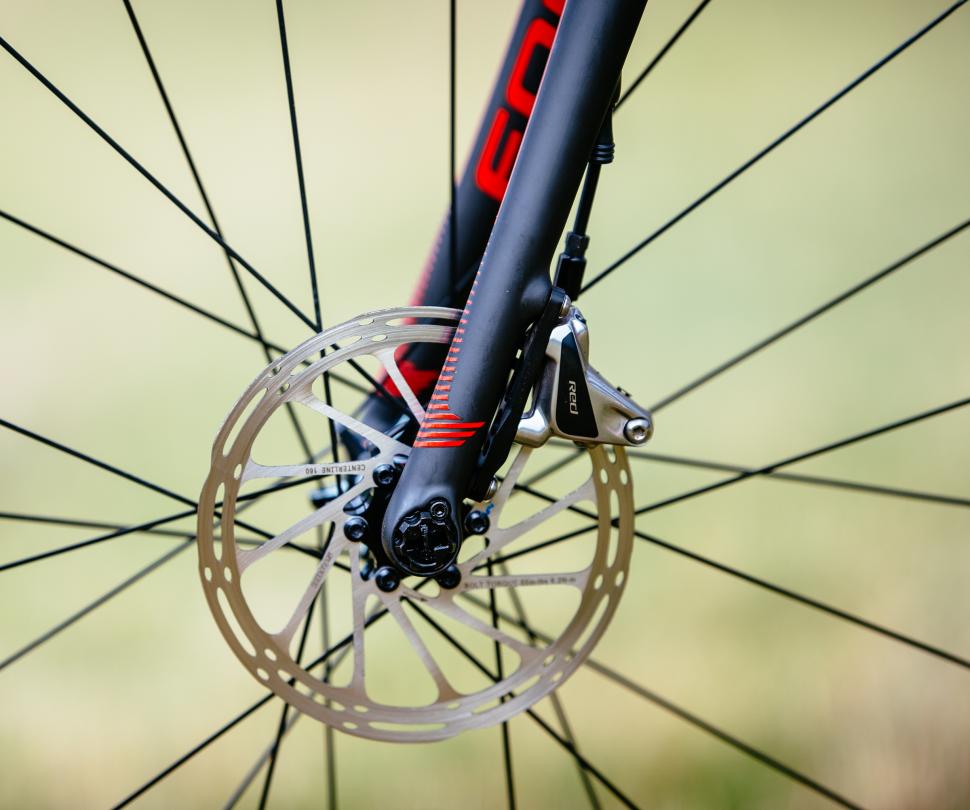


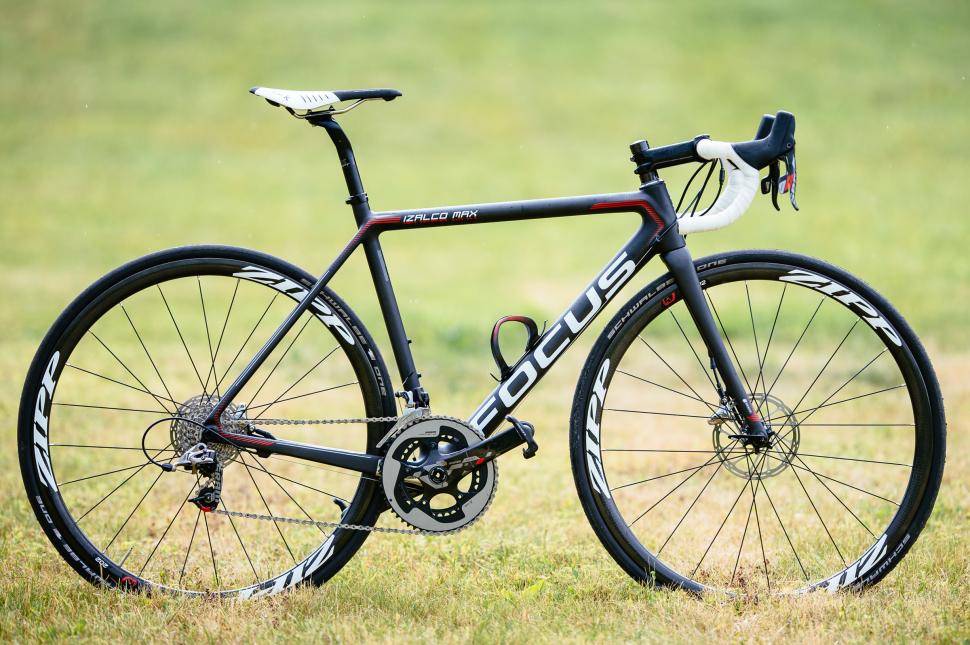




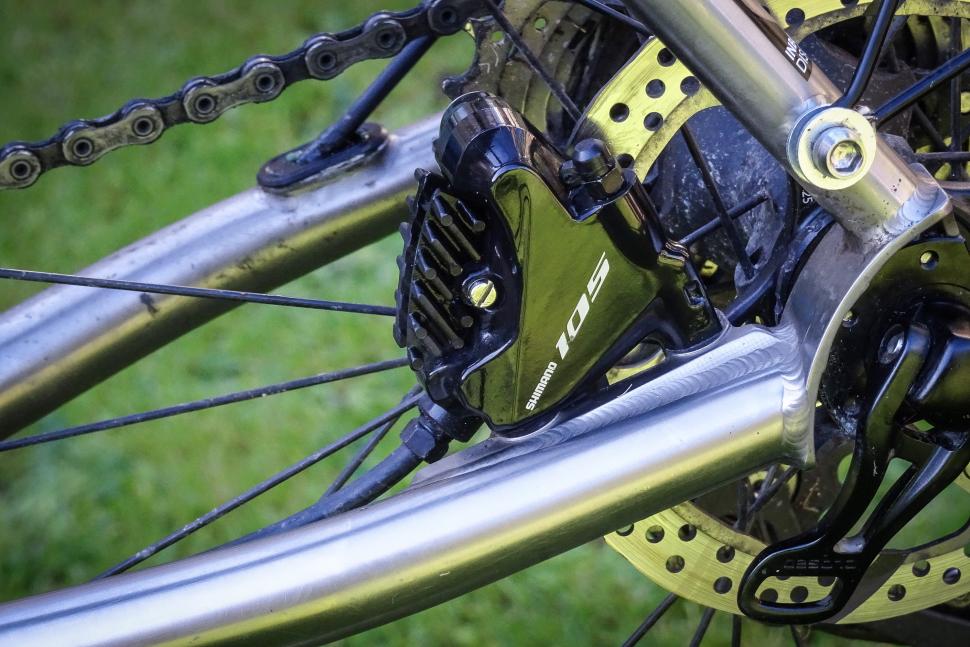
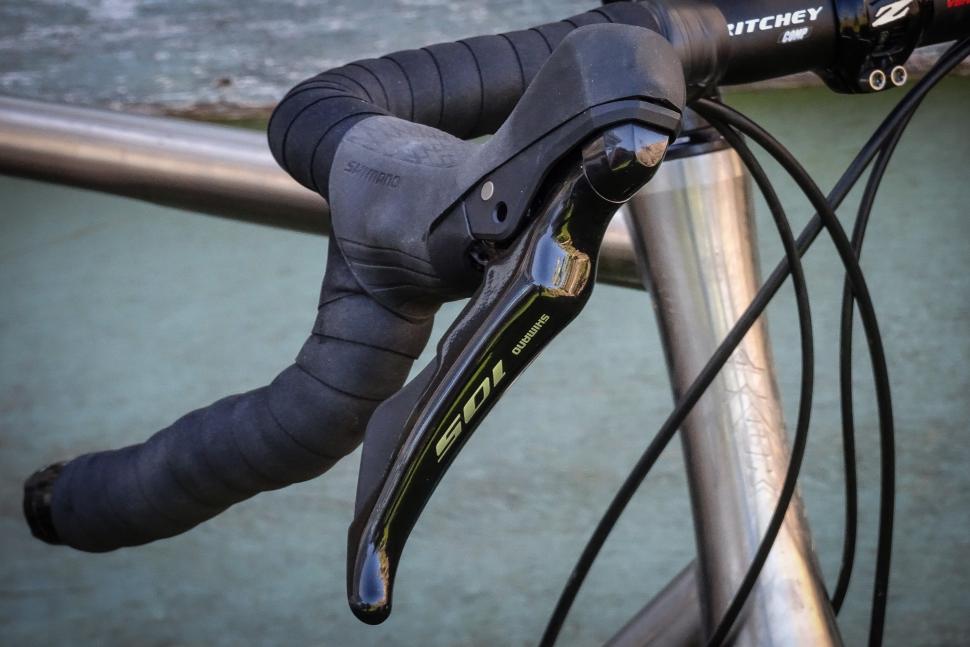


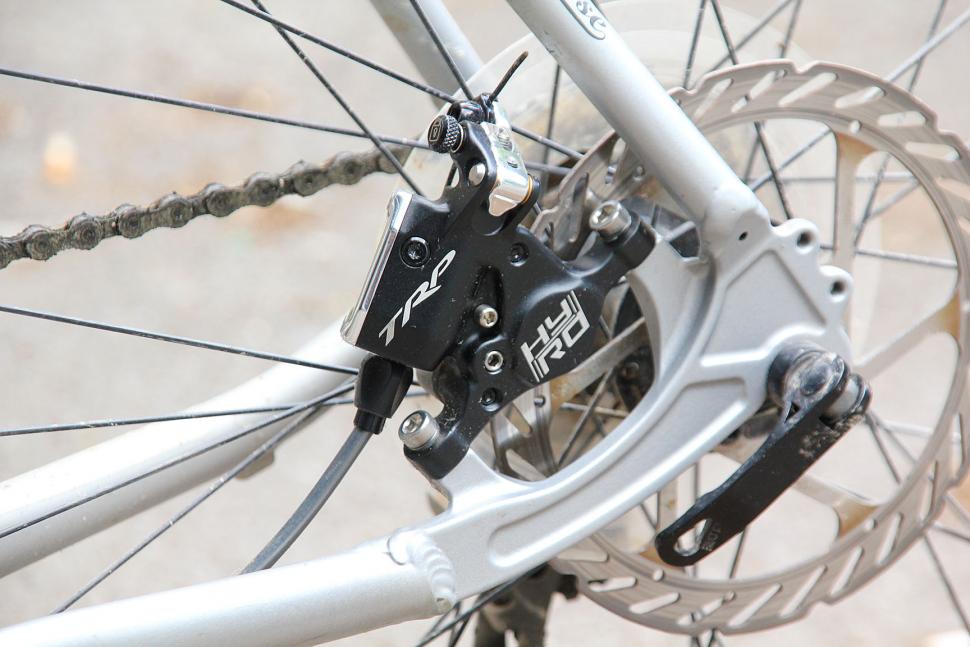



Add new comment
72 comments
you can change gear on your brifter with your foot? can i see the video? can you also brake with the foot?:D
With all the panache and bike handling skills I display, I might as well be doing so. , but the problem is I've got Campag feet and Shimano brifters. Incompatibility, you see...
, but the problem is I've got Campag feet and Shimano brifters. Incompatibility, you see...
for all the benefits of disc brakes, and they are considerable, maintenance and setup are key issues though as these spread down into more every day riders bikes, because Ive had friends with hydraulic brakes that had hellish problems trying to get them fixed when they went wrong, they seemed to just permanently leak, and it meant the bike was fundamentally unrideable as no-one is going to trust a brake system that might not be quite there when you need it.
and whilst the disk brakes on my road bike are cable operated (I was firmly put off the hassle of hydraulics) the margins between a free running disc and one that is slightly rubbing or modulating on braking because its slightly out of alignment, seems to be one of those measured in microns, maybe its fine if you dismantle your bike after every ride and clean every piece, before putting them back together, but outside of the obsessive and pro ranks most people dont do that or go on a how to setup brake discs course first to ride a bike.
for all their faults, rim brakes are dead simple to fix and maintain for the average rider, and thats a big plus in terms of usable bike technology IMO
A couple of key benefits missing from the first section:
1. No rim wear.
2. No more black brake sludge! (One of my favourite reasons to use discs.)
There is endless discussion of why disc brakes aren't better or aren't needed or are some marketing gimmick, and 99.9% of it comes from people who haven't used them. Try them, and you'll find that all the your reservations are misplaced—unless, perhaps, you're the sort who only uses 23mm tyres and won't venture out unless it's shorts weather and the tarmac's bone dry.
The only thing I don't like about discs is that you can't use radial lacing
Silver would be even better since it has twice the thermal conductivity of aluminium, as well as appealing to the luxury end of the market.
I'm holding out for that.
Really interesting discussion: really interesting to see the huge range of responses to this based on looks, weight, engineering, and even - probably the most important thing?-performance.
Maintenance issues: I had cable discs on my old MTB and did zero maintenance on them apart from a couple of pad changes in 5 odd years: I didn't even change the cables!! I crashed them, got them muddy/gritty/wet/hot/cold and abused them to death: every now and then I squirted the rotor with degreaser, dried it and "wiped it" with a bit of fine emery paper ( from the puncture repair kit for roughing up the inner prior to putting the rubber glue on in fact!). Hydros on the current one (not particularly great ones by the reviews) are a class above in terms of performance, and once bedded in, I haven't had to do anything for two years as yet, apart from pads.
Compared to all the rim brakes I ever had - even given the record of abuse and negligence the bikes got over time - they were a game changer as I never had to worry about them not working very well. In rubbish weather, nothing is going to work properly as everything is covered in water or filth or slime, but they do work better than rim brakes under these conditions in my experience.
Having said all of that, comparing discs on MTB's with Discs on road bikes is a bit unfair as you don't hit the same speeds on MTBs, (well, I don't ), and phrases like "aerodynamics" and "weight penalty" don't really enter into it unless you are racing. Or obsessed with pretending you are a racer.
), and phrases like "aerodynamics" and "weight penalty" don't really enter into it unless you are racing. Or obsessed with pretending you are a racer.
Surely for commuters and the average person they are, therefore, a no brainer?
Sadly so many of the above comments have little or no value. Why? Because its obvious that they have been written by someone who hasn't used discs on the road. If thats you, how the hell do you know? You don't.
Couple of errors as well. A hydro system isn't any hassle to maintain. I haven't done a thing to the disc brake system on my MTB except pads in the 7 years I have had it. Nothing. It doesn't need it. I replace cables on other bikes much more often. I guess this is one of those errors by those who haven't a clue.
Unlike some I must admit to having experience. I swappped my roughstuff bike to discs in 2010 and that soon became my road bike. The recent weather has given me countless examples whereby discs work better than rims. Can't say I saw anyone locking up a wheel yeaterday in the foul conditions except those on rims brakes whose braking needed lots of squeezing which then went from nothing to lock up.
Those who rant about complex systems are, I assume, still running a single speed system. I bet many of you embraced combined gear levers and brakes. You didn't need them so why?
Just accept that times change. I'll be the first to state that bikes looked at the best in the era just before integrated brakes and gear levers. Down tube shifters, hidden brake cable and not bloody black. However things change and when you try something you can make an informed and thus valid judgement.
I still refuse to see any virtue in black that isn't on the tyres.
I'm not sure that people are 'ranting'. In the case of multiple gears and STI levers I think the advantages were very clear.
With discs I think it is less clear cut, particularly for road bikes rather than cyclocross bikes. Dual pivots are a very effective braking system that are lighter, cheaper and more aerodynamic than discs.
Discs don't wear out rims, but then again my last wheels to give up the ghost were 9 years old, so I don't think it would be economic to change to discs just to avoid rim wear.
I'm agnostic really, but I might be more enthusiastic once a proper standard is in place re rotor size, and axle fittings.
@wycombewheeler
there is definitely a benefit for recreational riders in terms of being able to ride with more confidence in poor weather conditions, that is if you like/want to ride in poor weather conditions?
But for performance riding I'd like to see the "standards" settle down in terms of wheel axles (preferably a light weight through axle at either end) and for lighter weight disc wheels to be more affordable
If I look at the wheelset on my current caliper brake road bike, Shimano RS81 C24 for £315 coming in a smidgen over 1500gm; real nice feeling wheels which roll fast and are stiff under power
A quality disc wheelset from Giant for 2016 is their SLR 1 disc wheel system - 1650 gm for £850, and that is with a carbon fibre rim.
Quite a large difference in "value" between a caliper brake and disc brake bike when shopping.
It's funny how there are two camps of people arguing against disc brakes, one saying there is no benefit it's all a con from the manufacturers, and one saying the difference so so pronounced it isn't safe to have discs and non discs in the pro peleton together.
which is it?
Very few are saying that it's unsafe to have both disc formats in a peleton. There are already huge differences in the way riders slow down anyway (just look what happened to G in the tour), whether due to braking ability/confidance or line choice.
Disc brakes in the pro scene won't make much difference to the racing at all, other than in the wet when those on discs will have more confidance than those on rims.
However, saying that discs will have little impact on the pro racing does not make them irrelevant, because as all those on here who have tried them are saying, for the average joe they are the far better option. We just need the wheel/rim manufacturers bring out some inovations so that the current downsides to discs begin to disappear.
I've got (cable) disc brakes on my road bikes, have had for years. They're fantastic.
From my point of view, what's the advantage of rim brakes? none that i can see beyond perhaps a trivial weight saving.
Having got my first bike with disc brakes about 9 months ago (for touring and commuting) I'd say the advantages of rim brakes are less maintenance required. I know that seems to go against a lot of comments so maybe I am doing something wrong. Every few weeks at best - usually after having to do an hard brake to avoid cars/people/dogs on the bike path one of the rotors, usually the front, goes out of true and rubs on the pads. It's only very slight - I can't see it is out of true by eye but I can hear it and I bend it back and all is well for a few more weeks.
I've never had rim brakes that would do that. Obviously the wheel could go out of true but that was fairly uncommon once I bought decent rims.
I'm fearing it happening on a tour when I haven't got my disc truing tool with me.
My bike came with Shimano BR-M506 so not massively high end - maybe thats the problem.
The are like most cable discs in that only one pad moves when the brake is applied, and the disc is pushed across to the second pad. I have experience with loads of disc brakes and I've yet to come across a disc brake of similar design that hasn't presented some similar issue to the one you describe. The shimano ones are actually better than most, but still not great, although with the shimano ones it tends to be the rotor that presents the problem, and as with the calipers themsolves, rotors vary in quality. If you have one that's made of some form of cheese maskerading as steel, or one that wasn't made true, or wheel that has rotor mounts slightly out of alignment, or a frame where the mounts have not been aligned/faced correctly, then you have problems.
There is no doubt that disc brakes are more sensitive to manufacturing tolorances than rim brakes.
The TRP spyre brakes however are fantastic and have never presented me with any such issues (except when I tried fitting them to someones frame only to find the mount on the frame was not aligned correctly). They are as fit and forget as hydraulics, and it's all because both pads move, as per hydraulic brakes.
I suggest you switch your shimano brakes to Spyres or some Shimano hydraulics, and then you'll never want rim brakes again.
Personally speaking I wouldn't go back to rim brakes.
It's not just the widely acknowledged superior braking performance and reliability in all conditions, but I really like my carbon wheels and there are few things more traumatic on a bike than descending in the wet, hauling on the brake levers to little discernable retardation accompanied by the sound of your expensive carbon specific pads disintegrating and road grit grinding paste scouring your beautiful carbon rims. Been there, done that, got the brown streaks on my chamois! Well actually I threw that one away.
I'll happily trade a few extra grams near the hub for a reduction in rim weight and the added advantage of being able to design the rim entirely for the purposes of keeping the tyre on and being aerodynamic. Tubular tyres make even more sense if you don't mind the glueing.
In my experience, it is as easy or easier to remove and replace wheels with a disc setup. Brake bleeding is a once a blue moon activity, as is changing pads, easily done by a home mechanic, it's a very simple and gratifying task. I don't suffer 'brake rub', my disc brakes do not squeal very often, only when dirty but they do give out a 'ting, ting, ting' noise for a few moments as they cool from a hard descent.
Technical proficiency with one's equipment and riding skills are important but disc brakes are genuinely easier to modulate and give better feedback which have to improve rider safety. I commute on my mtb most days and I'm just a club cyclist at weekends with my good road bike, I'm not a professional cyclist. However, I do know that I will outbrake pretty much anyone in the group I ride with in the dry and by a wide margin in the wet, two fingered and with a big grin on my face and without my forearms getting pumped. At least I did until the better riders also got disc brakes.
Aesthetically, I prefer the disc to a caliper. In my opinion it's neater, the cabling can be more discreet and they look more technical which is complimentary to a modern carbon frame.
As to whether you 'need' them, well that's not really a very good question, do you really 'need' cotterless cranks? What is wrong with downtube shifters or toe clips? Aren't 7 gears enough? Solid rubber tyres have some advantages...I suspect that most of the remaining sour attitude to discs, and it really does come across as that, will disappear if and when Campag are able to offer a variant and when prices drop to make them available as standard equipment on sub £1000 bikes.
My last bike was a £2,600 carbon fibre road bike with Shimano Ultegra 11 speed / hydraulic discs, I rode this bike from November 2014 through to August 2015.
During this period I changed the rear brake pads twice, the front pads once. I ran a variety of tires including Conti's GP4000 II in the new 28c size, which was actually 31mm width when inflated.
With tires this large and sticky run at 80-85psi I never outbraked the tire, and most of my riding involves steep hills. The braking performance was very impressive in terms of modulation and stopping power, especially in the wet.
I come from years of mountain bike racing (downhill as well as cross country) and am very used to disc brakes. I tend to ride my road bikes very fast down hills as the road is wonderfully smooth compared to the off road trails I am used to (I also have a Specialized Stumpjumper 29'er)
I would have preferred through-axles on the road bike, as the front brake was noisy (rotor tinkle / swishing) when climbing or sprinting, and the rear wheel axle could shift under repeated heavy braking which caused a creaking under power, only cured by loosening the rear skewer, shimmying the wheel and tightening again.
My current bike is a £1800 carbon fibre road bike with Shimano Ultegra 11 speed and caliper brakes. I've had this bike since August 2015.
Apart from more limited braking in wet weather, I completely prefer my new bike. With the blue Swisstop brake pads the wet weather braking is not actually as bad as I remembered.
Its much quieter to ride, lighter and accelerates faster. There is over 1 kg weight difference, with the wheels coming in 300 g lighter which makes a massive difference.
For a commuting bike I'd go disc brake every time. For long distances in foul weather I'd go disc brake every time.
When I've looked at performance disc brake bikes again, you need to spend decent money to get a light bike to really enjoy that fast road bike feeling, especially the wheelsets which are often 1800-2000 g even on bikes around £2,500
Disc brake wheels definately have a way to go before we see the benefits that removing the brake track can have. Rim designers are currently still using fiarly standard rim designs, where maybe nothing more than a bit of smoothing has been done so that it appears the brake surace has gone.
Removing the brake surface will allow a bit more flexibility in terms of aero design, and should help lower rim weight.
Spoke and hub weight will increase a little, but the effect long term should be that the weight will move towards the centre of the wheel, and thus should get back to the current crop of lightweight wheels in terms of acceleration and handling (overall weight is likely to stay a little higher, but it's where this weight is on the wheel that affects performance - weight at the hub has very little affect when talking 100g here or there).
Until more R&D is done at the higher end, OEM dics wheels will remain fairly heavy because most cheap disc only rims out there at present are CX rims and it will take time for the higher end developments to trickle down.
There are however some very light disc wheels out there now - AM Classic Argent Discs for example (less than 1600g), and these use the same rim as the standard Argents.
The use of Discs in the pro races will have little effect on the racing, but it will speed up the development of lighter and more aero rims. Give is a couple of years and this will start finding it's way down to more sensible price points.
ignoring the pro/against arguments an excellent, detailed well written article - thank you
If you ride a lot of miles in all weathers disc brakes are a must. Unfortunately at the mo I am still riding bikes with V brakes. Keeping my bike rims and pads clean is a constant chore as well as the drive chain. For me my next bike I am building will be hydraulic disc braked, Rohloff IHG and Gates belt drive for truly low maintenance.
+1 for disc pads wearing far more slowly than rim pads. If you only ride your bike in the dry then discs offer less of an advantage, sure.
And I have pulled a wheel out of the fork by putting the brake on but that's because I'm a muppet, not because disc brakes are bad.
As someone with a modest amount of money to spend on my bike I am much happier spending a reasonable amount of cash on wheels that I know should last well rather than considering my rims to be consumables.
If cycling was just about aesthetics then I'd ride a track bike but as it is, for me it's more like form follows function.
I don't really buy into this whole "they're only developing this stuff to take our money" narrative. Of course businesses try to make money but I honestly think that most companies are motivated to make that money by making bikes and cycling better. Most people in the bike industry actually love bikes!
Lets face it, disks are heavier, costlier, less hassle free and arguably uglier but they have better performace. I have V-brakes and I am not 100% happy but my next bike will definitely have disk brakes, mechanical or hydraulic.
Conversion at my existing bike is a thought but so far the hydraulic brifters price is simply ridiculously expensive as they cost as much as complete commuter bike, let alone that there are no options for my trusty 9-speed Sora groupset.
So go on, lets embrace disk brakes, and prices soon will fall
'I see absolutely no need for discs ever on everyday road bikes'
I see a need, but then I own shares in companies who make these things. They are purely and simply a way to make more money for the manufacturers. You *really* need these new brakes. Oh, and a new bike to go with them. Oh, and new forks and wheels next time we change stuff around.
Through-axle. On a road bike. PMSL.
One of my bikes has Hydraulic Shimano disc brakes and through-axles. It also has an 853 steel frame and full length mudgaurds. It's my favourite bike. I don't understand why people get so riled up by what others ride.
Live and let live, eh?
I understand why some folk are reluctant to try disc brakes, nobody likes to see their view of the world turned upside down. But, though I am an old man living on his pension, I gave them a try, first on my hybrid. Wow, what a difference, better in every significant way. Now two of my three bikes run discs and when I eventually replace my 'best' machine, it will too.
You can argue against discs, you can stick to what you know, you can produce all sorts of science to back you up. And the best of luck to you, it's your bike and it's your life. But you are missing out on a significant leap forward in bicycle design. I don't know why or how, but that's the way it is.
If the component is called a rotor, why aren't they called rotor brakes? Surely, if they are called disc brakes, then the active component must be a disc.
Is this just a piece of added jargon to try to blind the gullible with science?
No, it's just to infuriate the pedantic.
So, yes then.
@matthewn5
1. They are also a disc that is about 25mm from the road surface and all the contaminants on it.
2. This is true. Nonetheless in 13 years of disc brake use with a front qr I have never, ever experienced a front wheel move in or pull out of the dropout.
3. Are cables really recycled in reality? In any case you can use cable disc brakes which are still very effective. As for the brake fluid, it takes about 25ml to fill a brake system. Yes, it has to go somewhere but then so does all the used grease and lube that you use on the rest of the bike. Shimano also use mineral oil, not dot fluid if that's a concern.
They're not a solution looking for a problem, for certain applications they're a better solution to an existing problem.
The more I look at road discs, the more I think it's poor design, a solution in search of a problem. Stopping on a bike isn't mostly about the brake efficiency, its tyre to road adhesion that limits the back, and overturning momentum that limits the front. Try slamming both brakes on: you'll skid the back before going over the bars (as seen in sportives). It's much more important to ride defensively, so you're ready to brake in time.
1. Rim brakes are in effect a 622mm disc. Much better mechanical efficiency than a 140mm disc.
2. If they'd decided on a caliper in front of the axle there would be no need to invent a new axle standard, because the reaction to braking force would have pulled the axle into the dropouts. That seems a decision based on style, not technology.
3. Cables can be replaced easily and are largely recycleable, with a little bit of plastic/teflon waste. Waste disc brake fluid is a toxic pollutant. If it's anything like motor brake fluid, it's very corrosive too. You can't put that in your recycling bin.
I can see the benefit on a commuter bike, in the rain and sleet, but for those why not use hub brakes as in Holland or Germany? They go on for ever, never get contaminated, and don't need maintenance.
Sure, rims get ground down slowly, but if you use handbuilts they can be replaced, and the old ones recycled, to make new stuff.
Discuss.
That's a bit of priceless information and the kind of solution I like, just move the caliper.
I agree discs are a solution looking for a problem or perhaps a solution to the problem of getting more money out of us.
And the pads don't last nearly as long.
Pages